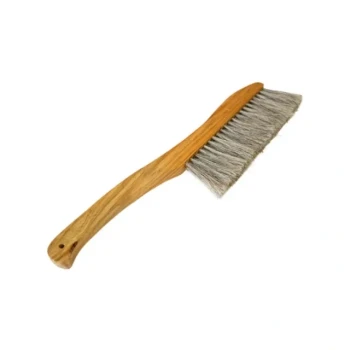At its core, a bee brush is a specialized tool used by beekeepers to gently sweep bees off surfaces, most notably honeycomb frames. This allows the beekeeper to perform inspections or harvest honey without causing injury to the bees or damage to the delicate wax structures of the comb.
The central challenge in beekeeping is interacting with a dense colony of insects safely and effectively. While tools like smokers manage bee behavior and suits protect the keeper, the bee brush is unique in its purpose: providing a gentle, physical means of relocating bees from a specific area.

The Core Function: Gentle and Precise Bee Removal
A bee brush is designed with a specific purpose in mind that dictates its construction and use. It is not an ordinary brush; it is a tool for careful animal husbandry.
Protecting the Bees
The defining feature of a bee brush is its long, soft bristles. This design is intentional to ensure that the fragile wings, legs, and bodies of the bees are not harmed during removal.
Injuring or killing bees during an inspection is counterproductive, as it stresses the colony and can reduce its overall population and productivity.
Preserving the Comb
Honeycomb is a delicate structure made of wax. A tool that is too harsh could easily crush cells, destroy brood, or spill honey, creating a mess that agitates the bees and requires them to expend significant energy on repairs.
The soft bristles of the brush are gentle enough to sweep over the comb without causing damage.
Key Scenarios for Use
Beekeepers use a brush primarily during hive inspections and honey harvesting. It allows them to clear bees from the tops of frames, the inner cover, or a specific frame they need to examine closely or remove from the hive.
The Bee Brush in the Beekeeper's Toolkit
To fully understand the brush's importance, it's helpful to see how it complements other essential beekeeping tools. Each tool serves a distinct, non-overlapping function.
The Role of the Smoker
A bee smoker is used to puff cool smoke into the hive, which calms the bees. The smoke works by masking the alarm pheromones that bees release to signal danger, preventing a colony-wide defensive response.
The smoker is a behavioral tool; it influences how the bees react. It does not, however, physically move them from a surface.
The Role of Protective Gear
A bee suit, including a veil and jacket, serves one primary purpose: to protect the beekeeper from stings. This gear provides a barrier but has no direct impact on the bees or the hive.
It is purely for the beekeeper's safety and confidence while working.
When a Brush is the Right Tool
A beekeeper uses a brush when the smoker has done its job of calming the colony, but bees still remain on a frame that needs to be handled. The brush provides the precise, physical action that smoke and protective gear cannot.
Understanding the Trade-offs
While essential, the bee brush must be used with skill and an understanding of its limitations. It is a tool for persuasion, not force.
The Risk of Agitation
Even with soft bristles, an aggressive or rapid brushing motion can be perceived as an attack. This can agitate the bees, causing them to become defensive and potentially sting.
The proper technique is a gentle, steady sweeping motion in one direction, encouraging the bees to simply walk away.
The Importance of a Light Touch
The goal is to gently nudge bees, not to scrub them off the frame. A light touch respects the bees and minimizes stress on the colony. Overly firm brushing defeats the purpose of the tool.
Making the Right Choice for Your Goal
Effective beekeeping relies on using the right tool for the right job to ensure the health of the colony and the safety of the keeper.
- If your primary focus is calming the colony before an inspection: Your essential tool is the bee smoker, used to mask alarm pheromones.
- If your primary focus is clearing a specific frame for harvest or inspection: Your essential tool is the bee brush, used with gentle sweeping motions.
- If your primary focus is personal safety from stings: Your essential equipment is a quality bee suit and veil.
Ultimately, the bee brush embodies a fundamental principle of beekeeping: to work with the bees in a way that is effective for the keeper and respectful of the colony.
Summary Table:
| Purpose | Key Benefit |
|---|---|
| Gentle Bee Removal | Soft bristles protect bee wings and bodies |
| Comb Preservation | Prevents damage to delicate wax honeycomb |
| Hive Inspection | Clears frames for detailed examination |
| Honey Harvesting | Safely removes bees from honey supers |
| Stress Reduction | Minimizes colony agitation during handling |
Equip your apiary with professional-grade beekeeping tools from HONESTBEE. Our high-quality bee brushes are designed for commercial beekeepers and distributors who demand durability and bee-friendly performance. Enhance your hive management efficiency and protect your valuable colonies. Contact our wholesale team today to discuss your equipment needs and volume pricing.
Visual Guide

Related Products
- Wooden Bee Brush with Triple Row Artificial Fiber for Beekeeping
- Wooden Bee Brush with Double-Row Horsehair Bristles
- Classic Wooden Bee Brush with Double-Row Boar Bristles
- Premium Triple-Row Horsehair Bee Brush
- Double Row Artificial Fiber Bee Brush for Beekeeping
People Also Ask
- What are the key features of a popular bee brush? Essential Design for Bee Safety and Hive Hygiene
- What are some optional tools that can be useful in beekeeping? Boost Efficiency & Hive Health
- How does using a bee brush benefit beekeepers and the hive? Achieve Gentle, Stress-Free Hive Management
- What is a bee brush and how is it used in beekeeping? A Guide to Gentle Bee Handling
- What are the characteristics of the bristles on a bee brush? Designed for Gentle Persuasion, Not Force



















